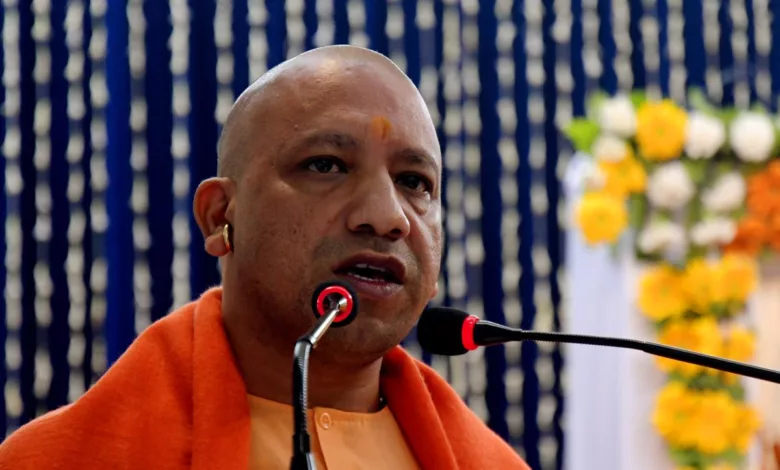UP Government Is Working To Grow The Economic Output To $1 Trillion, Yogi Adityanath
The success of Uttar Pradesh's development plan depends on its ability to infrastructure development and win over investors. The state administration intends to bring in investments of Rs 10 lakh crore over the following two years in anticipation of the World Investors.

UP Chief Minister Yogi Adityanath said that while his administration is attempting to grow Uttar Pradesh’s economy to a trillion dollars, Samajwadi Party leader Akhilesh Yadav is fostering casteism.
Adityanath remarked in response to a discussion about the state’s financial plans in the assembly that although his administration is striving to promote the One District, One Product (ODOP) program, the former SP dispensation had promoted “one district, one mafia” during its rule.
The ODOP project seeks to assist traditional industries connected to each district in order to strengthen the local economy and create jobs. The Uttar Pradesh administration is working hard, according to the chief minister, to increase its contribution to India’s GDP from its current level of 8 to 15 or 16 percent in order to support the country’s rapid development. He said that Yadav is actively promoting casteism in an effort to divert attention from the issue, despite the administration’s sincere efforts to build a state economy worth USD 1 trillion.
Whereas the last SP administration concentrated on promoting “one district, one mafia,” the BJP administration is pushing the ODOP system, Adityanath said. Shivpal Yadav was in the House when Adityanath responded, but Yadav was not.
Building a Massive Infrastructure Project
The success of Uttar Pradesh’s development plan depends on its ability to infrastructure development and win over investors. The state administration intends to bring in investments of Rs 10 lakh crore over the following two years in anticipation of the World Investors.
In addition to building an international airport, chief minister Adityanath has convened talks to investigate the feasibility of utilizing hydrogen fuel cell technology for power generation and the construction of the Ayodhya Dam. Adityanath has also established lofty goals for the public works department, which has been given the job of building 16,500 km of roads, 200 railways over bridges, 1,000 mini-bridges, and 300 bridges over the course of the next five years.
The state has more expressways and national roads than any other state in the nation. Prior to Adityanath taking office in 2017; there were just three airports; currently, we are developing 17. In Jewar, the biggest airport in Asia, is also under construction and will be finished on schedule. The availability of flights from Uttar Pradesh to nearly every destination has increased.”
According to N.R. Bhanumurthy, vice-chancellor of the Dr. B.R. Ambedkar School of Economics University in Bengaluru, there appears to be a change in how Uttar Pradesh is now functioning in comparison to a number of other states.
Leading industrialist Gautam Adani pledged an investment of Rs 70,000 crore at the third Uttar Pradesh Investors Summit, which was held in June of this year. The Adani Group also plans to invest Rs 24,000 crore in road and transportation infrastructure and Rs 35,000 crore in multi-modal logistics and the defence industry. At Kanpur, it is also working to construct the biggest munitions complex in South Asia.
Mukesh Ambani of Reliance Industries pledged to spend Rs 10,000 crore in the state through Reliance Jio over three years during the summit 2018. Jio has already committed Rs 20,000 crore to the state’s 4G communications project. The Tata Group said last year that it would give the Indian Air Force 56 C-295 combat planes in collaboration with Airbus. According to reports, Uttar Pradesh would be the most likely location for the Tata and Airbus production facility.
“The state seems to be receiving significant investments. The infrastructure of the highways has clearly improved. The state is developing a number of motorways and airports. All of these are assisting them in developing a marginally better brand than how the state was previously viewed, said Bhanumurthy. He claims that as growth might result in improved living conditions and increased opportunities for advancement, it is considered to improve other social variables. According to him, investments increase employment in the areas where they are made, and everything taken together offers people a better quality of life.
Bhanumurthy continues, “As far as the social sector is concerned, they may take longer to show progress. Factors like education, health metrics, and poverty won’t alter quickly.
Business in key markets difficulties to attract investment
The majority of private sector investment in India is still focused in states like Gujarat, Tamil Nadu, and Maharashtra, among others, even if a number of projects have been launched in Uttar Pradesh. According to a CARE Ratings assessment, Tamil Nadu attracted the most investment among Indian states in the first half of FY21. In Tamil Nadu, almost 16% of the total investments were made. In May 2020, in the midst of the epidemic, the Uttar Pradesh government suspended the majority of its labor rules for three years in an effort to entice investors and make conducting business easier.
“They must be granted a temporary exemption from the state’s labor regulations in order to promote new investments, build new industrial infrastructure, and benefit the state’s already-existing companies and businesses. As a result, it’s critical that Uttar Pradesh loosen its current labor restrictions over a three-year term. The “Uttar Pradesh Temporary Exemption from Certain Labour Regulations Ordinance, 2020″ has been introduced in order to achieve this “Then, the government released a statement.
“Natural resource-rich states have an inherent edge in luring firms. The simplicity of running business is crucial for attracting investors. A number of criteria must be considered in order to determine if a state is friendly to business, including the state’s labor laws, the quality of its physical infrastructure, and the level of education of its workforce. States that are able to handle these naturally have an edge when it comes to attracting investment, according to Devendra Pant, chief economist at India Ratings and Research.
Natural resources are an advantage for Uttar Pradesh from a geo-economics standpoint. One of the most productive regions in India is the Gangetic plain. Nowadays, agriculture contributes 23% to the gross state product (GSDP) of Uttar Pradesh, manufacturing contributes 27%, and services contribute 50%. Agriculture, forestry, and minerals constitute the foundation of Uttar Pradesh’s industry. With around 73 cotton mills, the handloom industry is one of the biggest in the state and ranks third in terms of the cotton textile sector. It operates 24 cooperative sugar mills under state management as the largest producer of sugarcane in the nation.
The manufacturing sector must increase five times from its current size of Rs 5.6 lakh crore to Rs 27.6 lakh crore in order for the economy to reach the $1 trillion mark. Agriculture would need to expand by 2.5 times to boost its contribution from the current level of Rs 4.7 lakh crore to Rs 11.8 lakh crore, while services would need to grow by 4 times to increase from the current level of Rs 10.3 lakh crore to Rs 40 lakh crore.
The Potential to Fuel Investment
Reforms in the electricity industry are crucial in addition to infrastructural development if large-scale industrialization is to be accomplished. State-owned distribution businesses (DISCOMS) are operationally and financially in disarray despite four significant changes over the past 15 years.
The Ujwal DISCOM Assurance Yojana (UDAY), introduced by the Ministry of Electricity in 2015, assisted the states for a time, but following the scheme’s expiration in FY20, the majority of them began to miss their goals and continue to incur losses.
The commercial and technical losses of Uttar Pradesh Power Corporation Ltd (UPPCL) would rise as the demand for electricity rises. Also, UPPCL is having trouble controlling widespread power theft and ineffective collection methods. The Uttar Pradesh government requested financial support around Rs 50,000 crore from the Center in December of last year under the Revamped Distribution Sector Plan. The DISCOM has pledged to reduce the UPPCL’s average total technical and commercial losses from 29 percent to 16 percent.
Agra DISCOM had the largest losses at 38.24%, followed by Varanasi (32.32%), and Lucknow (32.32%). (31.76 per cent). Losses for the DISCOMS in Meerut and Kanpur are significantly smaller, at 15.94% and 19.52%, respectively.
“A positive aspect of Uttar Pradesh is that it long had a revenue surplus. To ensure sustainable growth over the long run, they are attempting to make changes to their current policies. Yet it’s crucial to have a power infrastructure in place if you want to draw in investment. Moreover, social infrastructure is required, such as a skilled labor force (for formal sector jobs). “A state with superior electricity sector reforms and better road infrastructure will attract more investments, all other things being equal,” asserts Pant.
Law-and-order situation
The state’s level of law and order is a significant element for economic growth. A firm needs favorable social circumstances for efficient operations in order to survive and grow. Pathak said that under the terms of the Goonda Act, National Security Act, and Gangster Act, the government of Uttar Pradesh has implemented a zero-tolerance policy against crime and taken strong punishment against rioters, mafia members, and other anti-social (elements).
“In reality, our government has given the state police administration all the resources and independence it needs to deal with crime firmly, which has sent chills up the spines of criminals all around the state. We have made it quite apparent that criminal mentality has no place in the state. To keep the legal and security situation under control in whatever circumstance, we will even create new laws if necessary, he continued.
CM Adityanath slammed the past SP and BSP governments earlier this year for fostering chaos during their administrations, while claiming that no communal riots had broken out in the state since he took office in 2017. “The general status of law and order in Uttar Pradesh looks to have improved. In addition, the whole governance structure has improved significantly.
According to Bhanumurthy, this looks to be benefiting them in how they utilise public cash in compared to the past. CM Adityanath will continue to be the taskmaster to really deliver on his $1 trillion economic pledge and carve out a name for him as a strong leader who can inspire genuine change as the government pushes for extensive infrastructure building.
edited and proofread by nikita sharma




